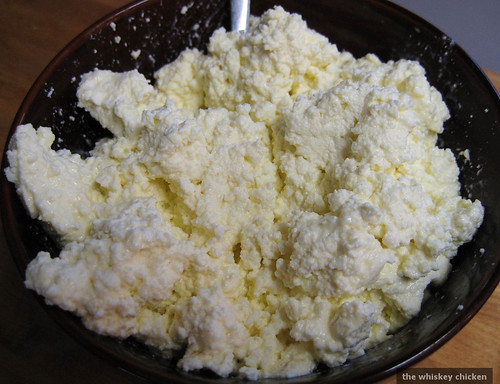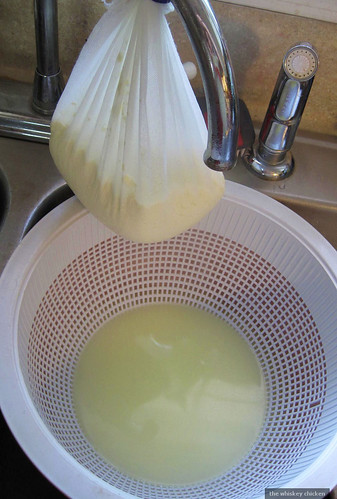With all of this meat curing that has been going lately, I admit I have strayed from my first true love. Just like with curing, cheese making can also be incredibly intimidating. There is so much involved: sanitation, science, a bit of alchemy, sensitive raw ingredients, crappy electric stove tops. But as with any new skill, it's best to start out with the basics and work (or rework) your way up. And so with making cheese, ricotta is about as basic and simple as one can get.
Traditionally, ricotta was made from the leftover whey of cheeses such as Pecorino Romano. Reheating the whey after a make created a small fine curd that was used fresh, and often times derived from sheep's milk. Unfortunately, I don't have any sheep's milk hanging around in the refrigerator (yet) so common cow's milk will have to suffice. While ricotta can be made using leftover whey, it can be made from whole milk as well, which also increases the yield. All you need to form soft curds is a little heat and acidity. I use lemon juice, but a good quailty vinegar could be used also.
 |
| Cheese at Work |
Fresh Ricotta (yields 2 cups)
Ingredients
2 quarts whole milk
2 cups heavy cream
1/2 tsp salt
3 T lemon juice
Line a colander with cheese cloth or butter muslin and set inside a large bowl.
Very slowly heat the milk, cream, and salt in a heavy bottom pot, stirring occasionally. (Do not walk away from milk on the stove to go check your email! No, not even if it will take "just a second"! It will boil over! Yes, I do it everytime)
When the milk comes to a slow rolling boil, add the lemon juice and stir until curds form, about 2 min.
Pour curds into lined colander. You may need to suspend the cheese if your bowl is not deep enough, as I have done here with twist ties and rubber bands. Sophisticated, I know.
Let the cheese drain for 1 hour.
Remove the cheese and mix in a little heavy cream or milk for a smoother consistency if you like.
Save the whey for pancakes, biscuits, or smoothies.
Save your cheese cloth and wash it, it is reusable.
You can keep your lovely handmade cheese in the refrigerator for 2 days, but I can't imagine why it would stick around for that long. So good in pasta, in eggs, in pastries, I'm sure you can find plenty of uses for it.
Since summertime in Georgia doesn't exactly scream lasagna weather, I adorned a simple pizza with mine. Piled high with fresh cheese, a hundred different vegetables from the garden/CSA, and served with a glass of cheap wine, it's nearly the perfect meal. Now, if I could only find time to make the damn crust...
 |
| Summertime and the living's |


I made this ricotta (but haven't tasted it yet) and now I NEED the recipe or directions for making the veggie pizza you have pictured. It looks awesome!!!
ReplyDeletePretty please? :)
Haha! Well I admit that I didn't make the crust this time, I just used a premade dough from a pizza kitchen. Although there really isn't much of a recipe, I just winged it.
ReplyDeleteI parbaked the crust for about 5 min. and then smeared it with a ton of the ricotta, then added a little tomato sauce (I simmered canned tomatoes with fresh herbs and salt), chicken sausage, parmesan, and every veggie I could get my hands on: squash, zucchini, onions, garlic, kale, cherry tomatos, cauliflower, broccoli, fennel, and potatoes (the last 4 I roasted in the oven for about 5 min. ahead of time).
I baked it for about 15 min. at about 400 and then added fresh basil, more garlic, scallions, and more parmesan. I tend to go a little overboard with toppings. :X